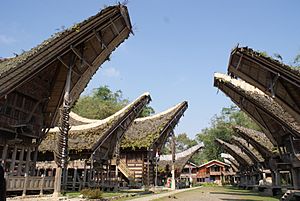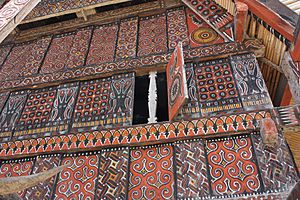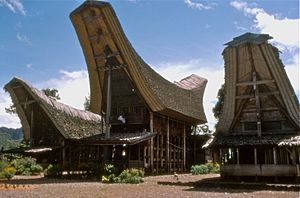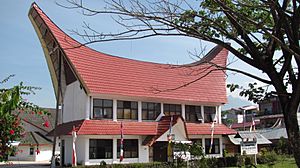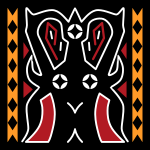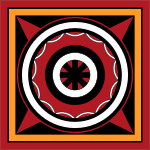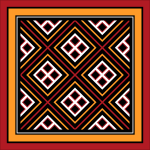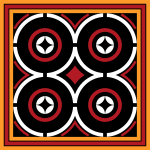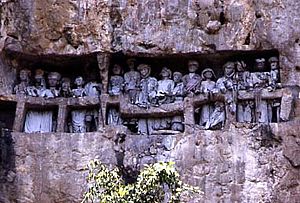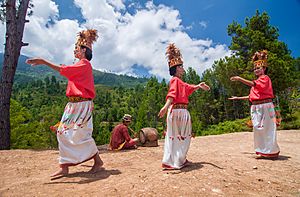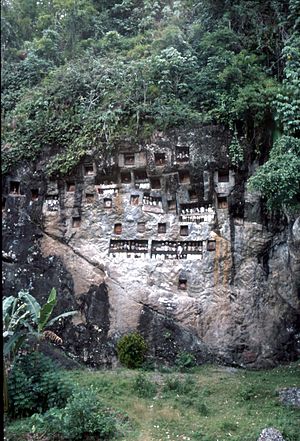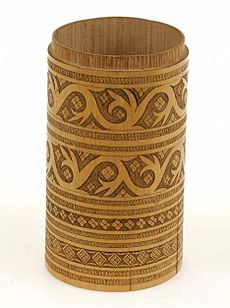Torajan people facts for kids

Torajan girls at a wedding ceremony.
|
|
| Total population | |
|---|---|
| 1,100,000 | |
| Regions with significant populations | |
| South Sulawesi | 600,000 |
| West Sulawesi | 179,846 (14% of the population; also known as Mamasa people) |
| Languages | |
| Toraja-Sa’dan language, Kalumpang language, Mamasa language, Tae’ language, Talondo' language, Toala' language (vernacular languages) and Indonesian | |
| Religion | |
| Christianity (Protestantism 69.14%, Roman Catholicism 16.97%), Islam (Sunni) 7.89% and Hinduism (Aluk To Dolo) 5.99%. | |
| Related ethnic groups | |
| Mamasa, Mandarese, Bugis, Makassar | |

The Torajans are a group of people who live in the mountains of South Sulawesi, Indonesia. About 1.1 million Torajans live there. Many of them, around 450,000, live in a special area called Tana Toraja, which means "Land of Toraja." Most Torajans are Christian. Others follow Islam or have their own local beliefs called aluk, which means "the way." The Indonesian government officially recognizes this ancient belief as Aluk To Dolo, or "Way of the Ancestors."
The name Toraja comes from the Buginese language. It means "people of the uplands." The Dutch government gave them this name in 1909. Torajans are famous for their special funeral ceremonies. They also carve burial sites into rocky cliffs. Their traditional houses, called tongkonan, have huge, peaked roofs. They also create colorful wood carvings. Toraja funerals are big social events. Hundreds of people usually attend them. They can last for several days.
Before the 1900s, Torajans lived in separate villages. They practiced their traditional beliefs. They didn't have much contact with the outside world. In the early 1900s, Dutch missionaries came. They tried to convert the Torajans to Christianity. In the 1970s, the Tana Toraja area became more open. It quickly became a popular place for tourism in Indonesia. Many tourists visited, and anthropologists studied their culture. By the 1990s, when tourism was at its peak, Toraja society had changed a lot. It went from being mostly farming-based with Aluk To Dolo customs to a mostly Christian society. Today, tourism and money sent home by Torajans working elsewhere have brought big changes. This has made the Toraja people well-known in Indonesia. It has also made them proud of their ethnic group.
Contents
Who Are the Torajan People?
Before the 1900s, Torajans didn't really think of themselves as one distinct group. They lived in mountain villages. Each village had its own identity. They didn't share a wide sense of being "Torajan." Even though rituals connected some villages, there were different dialects and social rules. The name "Toraja" was first used by people from the coast. It meant "people from the uplands." So, outsiders like the Bugis and Makassarese used the name more than the Torajans themselves.
When Dutch missionaries came to the mountains, Torajans started to feel more like a single group. This shared identity grew even more when tourism became popular in the Tana Toraja Regency. Now, South Sulawesi has four main ethnic groups. These are the Bugis, the Makassarese, the Mandarese, and the Toraja. The Toraja are known for growing rice in the highlands.
Torajan History
From the 1600s, the Dutch took control of trade and politics in Sulawesi. They did this through the Dutch East Indies Company. For about 200 years, they didn't pay much attention to the mountainous area where the Torajans lived. It was hard to reach and didn't have much farmland. In the late 1800s, the Dutch became worried about Islam spreading in southern Sulawesi. This was especially true among the Makassarese and Bugis people. The Dutch saw the Torajan highlanders, who followed animist beliefs, as possible Christians.
In the 1920s, a Dutch missionary group started working there. The Dutch government helped them. Besides bringing Christianity, the Dutch also ended slavery. They also made people pay local taxes. An area around Sa'dan was marked off and called Tana Toraja, meaning "the land of Toraja." Tana Toraja was first part of the Luwu kingdom. In 1946, the Dutch made Tana Toraja a special region. In 1957, it became one of the official regencies of Indonesia.

Early Dutch missionaries faced strong resistance. Especially from the Torajan leaders. They were angry because the Dutch ended their profitable slave trade. Some Torajans were forced to move to the lowlands. There, the Dutch could control them more easily. Taxes were kept high, which reduced the wealth of the leaders. In the end, Dutch influence didn't completely change Torajan culture. Only a few Torajans became Christian. By 1950, only 10% of the people had converted.
In the 1930s, Muslim groups from the lowlands attacked the Torajans. This led to many Torajans becoming Christian. They wanted to be on the side of the Dutch for protection. They also wanted to form a group against the Bugis and Makassarese Muslims. Between 1951 and 1965, after Indonesia became independent, southern Sulawesi had a difficult time. The Darul Islam group fought to create an Islamic state in Sulawesi. This 15 years of guerrilla warfare caused many people to convert to Christianity.
However, being allied with the Indonesian government didn't always keep the Torajans safe. In 1965, a new rule said that every Indonesian citizen had to belong to one of five official religions. These were Islam, Christianity (Protestant and Catholic), Hinduism, or Buddhism. The Torajan belief system, aluk, was not officially recognized. So, the Torajans protested this law. To make aluk legal, it had to be accepted as part of an official religion. In 1969, Aluk To Dolo ("the way of ancestors") was made legal. It became a part of Agama Hindu Dharma, which is the official name for Hinduism in Indonesia.
Torajan Society
Torajan society has three main parts: family, social class, and religion.
Family Life
Family is the most important social group for Torajans. Each village is like one big extended family. The main house of this family is the tongkonan, a traditional Torajan house. Each tongkonan has a name, which also becomes the village name. The family leaders help keep the village united. It's common for distant cousins (fourth cousins or further) to marry. This helps make family ties stronger. However, Torajan society usually doesn't allow close cousins to marry. This is to keep family property from being spread out. Family members actively help each other. They farm together, share in buffalo rituals, and help pay off debts.
Every person belongs to both their mother's and father's families. This is a unique family system in Indonesia. Children inherit connections to both parents' households. This includes land and even family debts. Children's names are often chosen based on family connections. They are usually named after relatives who have passed away. Names of aunts, uncles, and cousins are often used in the names of parents and siblings.
Before the government officially managed Toraja villages, each village was independent. If one family couldn't solve a problem alone, several villages would team up. Sometimes, villages would even unite against others. Family relationships were shown through blood ties, marriage, and shared ancestral houses (tongkonan). This was often sealed by exchanging water buffalo and pigs during special ceremonies. These exchanges built political and cultural ties. They also showed each person's place in society. For example, who could pour palm wine, who prepared offerings, where people could sit, and even what piece of meat they would get.
Social Classes
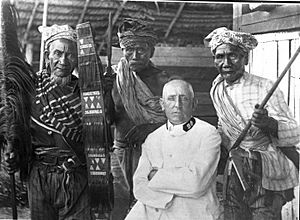
In old Toraja society, family ties were closely linked to social class. There were three main levels: nobles, commoners, and slaves. Slavery was ended in 1909 by the Dutch East Indies government. A person's class was inherited from their mother. So, it was forbidden to marry a woman from a lower class. However, marrying a woman from a higher class could improve the status of the next generation. Even today, nobles still show a proud attitude towards commoners. This is to maintain their family's prestige.
Nobles were believed to be direct descendants of people who came from heaven. They lived in tongkonans. Commoners lived in simpler houses made of bamboo, called banua. Slaves lived in small huts built near their owner's tongkonan. Commoners could marry anyone. But nobles preferred to marry within their own family to keep their high status. Sometimes nobles married nobles from the Bugis or Makassarese groups. Commoners and slaves were not allowed to have big death feasts. Even with strict class rules, some people could move up or down in status. This could happen through marriage or by gaining wealth. Wealth was measured by how many water buffaloes a person owned.
Slaves in Toraja society were considered family property. Sometimes, Torajans chose to become slaves to pay off a debt. They would work to repay what they owed. Slaves could also be taken during wars, and trading slaves was common. Slaves could buy their freedom, but their children would still be born into slavery. Slaves were not allowed to wear bronze or gold. They couldn't carve their houses or eat from the same dishes as their owners. Being in a relationship with a free woman was a serious crime, even punishable by death.
Religious Beliefs
Religion of Torajan people Protestantism (69.14%) Roman Catholic (16.97%) Sunni Islam (7.89%) Torajan Hinduism (Aluk To Dolo) (5.99%)
The traditional Toraja belief system is called aluk, or "the way." It's a type of polytheistic animism. In Toraja myths, the first Torajan people came down from heaven using stairs. These stairs were then used by Torajans to talk with Puang Matua, the Creator. According to aluk, the world has three parts: the upper world (heaven), the world of humans (earth), and the underworld. Heaven and earth were first married, then there was darkness, a separation, and finally light. Animals live in the underworld. The earth is for humans. The heaven world is above, with a saddle-shaped roof. Other Toraja gods include Pong Banggai di Rante (god of Earth) and Pong Lalondong (god of death). There are many more.
The earthly leader, whose words and actions should be followed, is called to minaa (an aluk priest). Aluk is more than just a belief system. It's a mix of law, religion, and customs. Aluk guides social life, farming practices, and rituals for ancestors. The details of aluk can be different in each village. One common rule is that death rituals and life rituals must be kept separate. Torajans believe that mixing them could harm the deceased. Both types of rituals are equally important.
The Toraja religion started to decline when the Dutch brought Christianity. During the time of the Dutch missionaries, Christian Torajans were not allowed to attend or perform life rituals. But they were allowed to do death rituals. Because of this, Toraja death rituals are still practiced widely today. However, life rituals have become much less common. Today, only a small number of Torajans practice their traditional religion.
Torajan Culture
Tongkonan Houses
Tongkonan are the traditional ancestral houses of the Torajan people. They are built high on wooden poles. They have a unique, curved roof made of layered split-bamboo. The outside walls are carved with detailed red, black, and yellow designs. The word "tongkonan" comes from the Torajan word tongkon, which means "to sit."
Tongkonan houses are at the heart of Torajan social life. The rituals connected to the tongkonan are very important for Torajan spiritual life. All family members are expected to take part. This is because the tongkonan represents links to their ancestors, living relatives, and future family. According to Torajan myth, the first tongkonan was built in heaven on four poles. Its roof was made of Indian cloth. When the first Torajan ancestor came to earth, he copied this house and held a big ceremony.
Building a tongkonan takes a lot of hard work. The extended family usually helps. There are three types of tongkonan. The tongkonan layuk is the house of the highest authority. It serves as the "center of government." The tongkonan pekamberan belongs to family members who have some power in local traditions. Regular family members live in the tongkonan batu. In the past, tongkonan houses were only for nobles. But now, many common Torajans find good jobs in other parts of Indonesia. They send money back to their families. This allows them to build larger tongkonan houses.
The tongkonan style of architecture is still very popular. Many government buildings have been built in this style recently. An example is the Kecamatan building in Rantepao.
Wood Carvings
Torajans carve wood to show their social and religious ideas. They call this Pa'ssura, or "the writing." So, wood carvings are a big part of Toraja culture.
Each carving has a special name. Common designs include animals and plants that represent good qualities. For example, water plants and animals like crabs and tadpoles often mean fertility. In some areas, noble elders say these symbols show the strength of their noble family. But not everyone agrees. The full meaning of groups of carvings on houses is still debated. Tourism has made these discussions more complex. Some people feel a single explanation must be given to tourists. Torajan wood carvings have many square panels. Each panel can represent different things. For example, buffaloes can mean a wish for wealth for the family. A knot and a box can symbolize the hope that all family members will be happy and live in peace. Aquatic animals can mean the need for fast and hard work, like moving on water.
Toraja wood carvings often show order and repeating patterns. They also use abstract and geometric designs. Nature is often the basis for Toraja ornaments. This is because nature has many abstract shapes and regular patterns. Toraja ornaments have been studied in ethnomathematics to find their mathematical structure. However, Torajans create this art using only rough ideas. They use bamboo sticks as a tool to create the geometric shapes.
On March 24, 2022, about 125 Toraja patterns received special copyright certificates. This was done by the Ministry of Law and Human Rights. It helps protect these traditional cultural designs.
Funeral Rites
In Toraja society, the funeral ritual is the most detailed and expensive event. The richer and more powerful the person who died, the more costly the funeral. In the aluk religion, only nobles were allowed to have a very large death feast. A nobleman's death feast is usually attended by thousands of people. It can last for several days. A special ceremonial area, called rante, is set up in a large grassy field. The family of the deceased builds shelters for guests, rice barns, and other structures there. Flute music, funeral chants, songs, poems, and crying are traditional ways Torajans show sadness. This is not done for funerals of young children or poor adults.
The ceremony is often held weeks, months, or even years after the death. This gives the family time to gather the large amount of money needed for the funeral. Torajans traditionally believe that death is not a sudden end. Instead, it's a slow journey towards Puya, the land of souls or afterlife. During this waiting period, the body of the deceased is wrapped in many layers of cloth. It is kept under the tongkonan house. The soul of the deceased is believed to stay around the village until the funeral ceremony is finished. After that, it begins its journey to Puya.
Another important part of the ritual is sacrificing water buffalo. The more important the person who died, the more buffalo are killed at the death feast. Buffalo bodies, including their heads, are usually lined up in a field. They wait for their owner, who is in the "sleeping stage." Torajans believe the deceased will need the buffalo for their journey. They also believe they will reach Puya faster if they have many buffalo. Killing tens of water buffalo and hundreds of pigs with a machete is the main part of the big death feast. There is dancing and music. Young boys catch the spurting blood in long bamboo tubes. Some of the animals are given by guests as "gifts." These gifts are carefully noted. They are considered debts that the deceased's family will owe later.
A cockfight, called bulangan londong, is also a key part of the ceremony. Like the sacrifice of buffalo and pigs, the cockfight is considered sacred. This is because it involves spilling blood on the earth. The tradition requires at least three chickens to be sacrificed. However, it's common for at least 25 pairs of chickens to fight during the ceremony.
There are three ways to bury the dead. The coffin can be placed in a cave or a carved stone grave. Or it can be hung on a cliff. The coffin contains anything the deceased might need in the afterlife. Wealthy people are often buried in stone graves carved into rocky cliffs. These graves are usually expensive and take several months to complete. In some areas, a large stone cave might be found that can hold an entire family. A carved wooden effigy, called Tau tau, is usually placed in the cave. It looks out over the land. The coffin of a baby is placed inside a living tree, in a special "baby tree."
In a ritual called Ma'Nene, which happens every August, the bodies of the deceased are taken out. They are washed, groomed, and dressed in new clothes.
Dance and Music
Torajans perform dances on different occasions. Most often, they dance during their detailed funeral ceremonies. They dance to show their sadness. They also dance to honor and cheer the person who died. This is because the deceased is going on a long journey to the afterlife. First, a group of men form a circle. They sing a simple chant all night to honor the deceased. This ritual is called Ma'badong. Many Torajans see this as the most important part of the funeral.
On the second day of the funeral, the Ma'randing warrior dance is performed. This dance praises the courage of the deceased during their life. Several men perform the dance with a sword, a large shield made from buffalo skin, and a helmet with a buffalo horn. The Ma'randing dance happens before a procession. In this procession, the deceased is carried from a rice barn to the rante, the funeral site. During the funeral, older women perform the Ma'katia dance. They sing a poetic song and wear a long feathered costume. The Ma'akatia dance reminds everyone of how generous and loyal the deceased person was. After the bloody ceremony of buffalo and pig slaughter, a group of boys and girls clap their hands. They perform a cheerful dance called Ma'dondan.
Like other farming societies, Torajans dance and sing during harvest time. The Ma'bugi dance celebrates thanksgiving. The Ma'gandangi dance is performed while Torajans are pounding rice. There are also several war dances. For example, the Manimbong dance is performed by men. It is followed by the Ma'dandan dance performed by women. The aluk religion decides when and how Torajans dance. A dance called Ma'bua can only be performed once every 12 years. Ma'bua is a major Toraja ceremony. During this dance, priests wear a buffalo head and dance around a sacred tree.
A traditional Toraja musical instrument is a bamboo flute called a Pa'suling. This six-holed flute is played at many dances. For example, it's used in the thanksgiving dance Ma'bondensan. Here, the flute plays along with a group of shirtless men with long fingernails who are dancing. The Toraja also have their own musical instruments. These include the Pa'pelle (made from palm leaves) and the Pa'karombi (the Torajan version of a jaw harp). The Pa'pelle is played during harvest time and at house opening ceremonies.
Torajan Language
The Toraja language is widely spoken in Tana Toraja. The main language is Sa'dan Toraja. Although the national Indonesian language is the official language and is spoken by the community, all elementary schools in Tana Toraja teach the Toraja language.
Different versions of Toraja language exist. These include Kalumpang, Mamasa, Tae, Talondo, Toala, and Toraja-Sa'dan. They all belong to the Malayo-Polynesian language family, which is part of the Austronesian group. At first, the isolated mountains of Tana Toraja led to many different dialects within the Toraja languages. After Tana Toraja was officially managed, some Toraja dialects were influenced by other languages. This happened because of a program to move people, which started during the colonial period. This program has been a big reason for the variety in Toraja languages.
| Denominations | ISO 639-3 | Population (as of) | Dialects | ||
|---|---|---|---|---|---|
| Kalumpang | kli | 12,000 (1991) | Karataun, Mablei, Mangki (E'da), Bone Hau (Ta'da). | ||
| Mamasa | mqj | 100,000 (1991) | Northern Mamasa, Central Mamasa, Pattae' (Southern Mamasa, Patta' Binuang, Binuang, Tae', Binuang-Paki-Batetanga-Anteapi) | ||
| Ta'e | rob | 250,000 (1992) | Rongkong, Northeast Luwu, South Luwu, Bua. | ||
| Talondo' | tln | 500 (1986) | |||
| Toala' | tlz | 30,000 (1983) | Toala', Palili'. | ||
| Torajan-Sa'dan | sda | 500,000 (1990) | Makale (Tallulembangna), Rantepao (Kesu'), Toraja Barat (West Toraja, Mappa-Pana). | ||
| Source: Gordon (2005). | |||||
An important feature of the Toraja language is how it expresses grief. The importance of death ceremonies in Toraja culture has shaped their language. It has many words to describe different levels of sadness, longing, depression, and mental pain. Clearly expressing the emotional and physical effects of loss can be a way to feel better. Sometimes, it can even lessen the pain of grief itself.
Torajan Economy
Before Suharto's "New Order" government, the Torajan economy was based on farming. They grew wet rice in terraced fields on mountain slopes. They also grew extra cassava and maize crops. A lot of time and effort went into raising water buffalo, pigs, and chickens. These animals were mainly for ceremonial sacrifices and eating. Coffee was the first important crop that Torajans sold for money. It was introduced in the mid-1800s. This changed the local economy. People started producing goods for outside markets. Torajan coffee became known for its excellent quality around the world.
When the New Order began in 1965, Indonesia's economy grew. It also opened up to foreign investment. In Toraja, a coffee plantation and factory were set up by Key Coffee from Japan. Torajan coffee again became known for its quality in the growing international specialty coffee market. Large international oil and mining companies started new operations in Indonesia during the 1970s and 1980s. Torajans, especially younger ones, moved to work for these foreign companies. They went to Kalimantan for timber and oil, to Papua for mining, and to cities in Sulawesi and Java. Many also went to Malaysia. Torajans steadily moved away until 1985, and this has continued since. The money sent back by Torajans working elsewhere plays a big role in the economy today.
Tourism started in Toraja in the 1970s. It grew quickly in the 1980s and 1990s. Between 1984 and 1997, many Torajans earned money from tourism. They worked in and owned hotels, as tour guides, drivers, or selling souvenirs. In the late 1990s, political and economic problems in Indonesia arose. This included religious conflicts in other parts of Sulawesi. Because of this, tourism in Tana Toraja dropped a lot. Toraja is still well-known for Indonesian coffee. It is grown by both small farmers and large plantations. However, moving away, money sent home, and other jobs are now more important for most households, even in rural areas.
Tourism and Cultural Changes
Before the 1970s, Toraja was almost unknown to Western tourists. In 1971, about 50 Europeans visited Tana Toraja. In 1972, at least 400 visitors attended the funeral of Puang of Sangalla. He was the highest-ranking nobleman in Tana Toraja. He was called the "last pure-blooded Toraja noble." National Geographic recorded this event. It was shown in several European countries. In 1976, about 12,000 tourists visited the area. In 1981, Torajan sculpture was shown in big museums in North America. The exhibition brochure called it "The land of the heavenly kings of Tana Toraja." The area was opening up to the outside world.
In 1984, the Indonesian Ministry of Tourism called Tana Toraja Regency the "prima donna" of South Sulawesi. Tana Toraja was promoted as "the second stop after Bali." Tourism grew very fast. By 1985, 150,000 foreigners had visited the area. Also, 80,000 local tourists came. In 1989, 40,000 foreign visitors were recorded annually. Souvenir stands appeared in Rantepao, the cultural center of Toraja. Roads were paved at the most visited tourist spots. New hotels and restaurants for tourists opened. An airport was built in the area in 1981.
Tourism companies promoted Tana Toraja as an exciting adventure. They said it was a place rich in culture and off the usual path. Western tourists expected to see stone-age villages and pagan funerals. Toraja was for tourists who had already been to Bali and wanted to see more "untouched" islands. However, they were more likely to see a Torajan wearing a hat and jeans, living in a Christian society. Tourists felt that the tongkonan and other Torajan rituals were being used just to make money. They complained that the place was too commercialized. This led to some disagreements between Torajans and tourism companies. Torajans saw the companies as outsiders.
A conflict happened in 1985 between local Torajan leaders and the South Sulawesi provincial government. The government was developing tourism. It named 18 Toraja villages and burial sites as traditional tourist attractions. Because of this, rules were put on these areas. Torajans themselves were not allowed to change their tongkonans and burial sites. Some Torajan leaders opposed this plan. They felt that outsiders were deciding their rituals and traditions. As a result, in 1987, the Torajan village of Kété Kesú and other tourist spots closed their doors to tourists. This closure only lasted a few days. The villagers found it too hard to live without the money from selling souvenirs.
Tourism has also changed Toraja society. Originally, there was a ritual that allowed commoners to marry nobles (puang). This would let their children gain nobility. However, the image of Torajan society created for tourists, often by lower-ranking guides, has weakened its traditional strict social order. High status is not as respected in Tana Toraja as it once was. Many men from lower classes can now claim to be nobles, and their children too. They do this by earning enough money working outside the region. Then they marry a noble woman.
See also
 In Spanish: Toraya para niños
In Spanish: Toraya para niños
- Demographics of Indonesia
- Torajan Muslims
- Tourism in Indonesia
- Proto-Malay
- Anito


